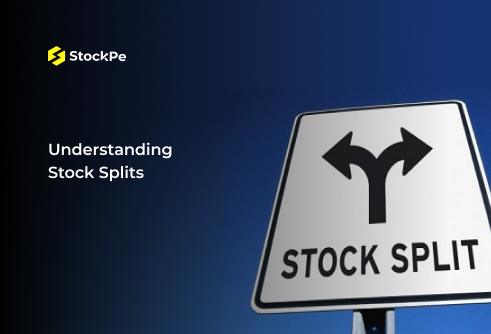Stock split, whereby a company fragments its stock to make the stock more liquid, is among the common acts that firms adopt when it comes to the stock market. As much as the move has merits, it does have demerits that are worth mentioning. Both investors and companies must be aware of these disadvantages to ensure that they can avoid them and make the right decisions on where and how to invest.
This article is a detailed guide on stock split, specifically the disadvantages of a stock split in the stock market game.
What is a Stock Split?
A stock split is a process whereby a company issues a large number of its shares to the public after evaluating its existing stocks. The most frequent split rates are 2:1 or 3:1, which imply that every stockholder is given two or three shares for any share which he or she formerly had.
This means that although there are more shares available in the market after the split the total value of outstanding shares does not change because the price per share is reduced in the same ratio.
How does a Stock Split work?
A stock split is usually carried out when the price of a firm’s shares skyrocket to a range that can be interpreted by potential investors as too expensive. Through the process of splitting the stock, the company makes the shares more accessible, and the circulation becomes better.
For example, if the stock of a company with 20 million shares has a price equal to 100$ per share and the company declares a stock split in a ratio of 2:1, the number of outstanding shares will be 40 million after the split and price per share will be only 50$. However, it does not alter the company’s market capitalization which is still $2 billion as per this example.
Benefits of Stock Splits
Here are the benefits of stock splits:
- Increased Accessibility: By cutting the share prices, there is an increase in the number of people who can afford to own shares thus increasing the number of investors.
- Enhanced Liquidity: Higher amount of floats explains the availability of more shares at a cheaper price thus enhancing market turnover.
- Positive Perception: Stock splits can be regarded as the sign of some company strength and confidence in further improvement.
- Balanced Portfolio: This is because such prices enable portfolio diversification, which might lead to an increased number of small investors.
- Increased Visibility: Stock splits can also attract media attention, which raises awareness and could lead to higher demand from the company’s stock.
Disadvantages of a Stock Split
Stock splits can have several disadvantages. It is crucial to give deeper insight into these disadvantages of stock split to get a better understanding about its negative impacts.
The High Cost of Execution
If one decides to undertake a stock split, one is likely to incur a number of administrative expenses. Business entities need to change records, recall and reissue stock certificates and ensure compliance with relevant laws and regulations. These processes are often cumbersome and quite costly.
Undertaking a stock split is a process that is usually governed by stringent legal and regulatory frameworks that a company needs to observe and therefore it is not a straightforward process. This sometimes entails outsourcing the services of legal personnel, which also adds to the costs.
No Fundamental Change in Value
Stock split is just a matter of arithmetic and it does not alter the actual value of the firm. The total market capitalization is constant as there is the expansion of the share number with the proportionate reduction of the share price. This can at times provide an impression of increased value, which in some cases may be misleading for the investors.
A few investors may be misled into thinking that a company’s stock split in a particular share means that the firm has expanded or made some improvements in its fundamentals. It can cause over expectation and may also be associated with the overstating of the market value.
Increased Volatility
Although stock split has its merits such as making shares cheaper hence increasing floating stock, it also has demerits such as frequent fluctuations in price. Higher share availability may increase trading volume and exaggerate price fluctuations.
A lower share price after the split is a possibility and this can attract new traders who may not be interested in long-term investment. This can lead to more fluctuations and unpredictability which may be disruptive to those who prefer to hold stock for several years.
Impact on Institutional Investors
A large percentage of institutional investors choose high priced stocks because they are considered to be less volatile and more suited for the investor than low priced stocks. One drawback of a large stock split is that it can reduce the stock’s appeal to these investors.
It may also force institutional investors to rebalance their portfolios, which may incur additional cost mainly due to transaction costs and other related expenses.
Potential for Delisting
The NASDAQ and NYSE in particular require that an organization’s shares must be at least a certain value before it is listed on their platforms. For instance, if a company’s stock price goes below a specified figure such as $1 it may be expelled from trading. Typically, most stock splits are carried out to bring down a steep price per share, however, subsequent market fluctuations can bring the post split share value below the required level.
The companies with low value of price of shares after split are more sensitive to changes in the market. Loss of market value triggers a compliance concern by exchange and if not addressed, leads to delisting.
Psychological and Market Perception Effects
High frequency of stock splits may create an illusion that a firm is manipulating its shares prices with an intent to mislead investors. It could lead to scepticism and lower corporate credibility among investors, thus having worse effects.
Market sentiment can be affected by the announcement of a stock split. For some investors, it is a sign of optimism; others, however, will interpret such a signal as indicating that the stock was overpriced earlier, which can cause mixed sentiment and create uncertainty in the market.
Case Studies
Apple Inc. (AAPL) – 2020 Stock Split
On the 28th of August, Apple had a 4 for 1 stock split with the intention of making the stocks more affordable. Before the division, it was offered at a higher cost, to be precise, at more than $500. The split made the shares easily available but at the same time took the company through extreme fluctuations in the short term.
Impact:
- Short-Term Surge: For the product at an adjusted price of about $125, there was a revival of interest in retail investors and short term trading.
- Increased Volatility: The split contributed to an increased trading volume and volatility of prices.
- Long-Term Performance: Apple’s stock rose further, proving that the company fundamentals remained strong.
NVIDIA Corporation (NVDA) – 2024 Stock Split
NVIDIA embarked on a 10-for-1 stock split on the 22 nd of May, 2024 to increase investors’ access with the stock price dropping from $600 to $60. Liquidity was enhanced, but volatility and trading problems surfaced with the division.
Impact:
- Enhanced Accessibility: Lower prices brought more regular investors on board with their trading activities.
- Market Reaction: These changes increased trading volume, and therefore, intra-day fluctuations that resulted in short-term unpredictability.
- Subsequent Challenges: There were stock oscillations resulting from speculation that affected its stability.
Conclusion
Although stock splits are useful in promoting stocks to more people due to increased liquidity and affordableness, they also have some disadvantages. Managers need to weigh costs, heightened risk, effect on institutional investors and risks tied with maintaining low float or minimum prices. As for the investors, they should not be influenced by the mere psychological aspect of stock splits and just go with the flow but rather pay close attention to the value and the potential of the company. The knowledge of such disadvantages is likely to assist companies as well as investors to make wiser decisions in the constantly shifting stock market environment.
FAQs
1. What are the reasons companies engage in stock splits?
Share splits can make the stock cheaper thereby advancing its liquidity and possibly popularity among investors. It is commonly interpreted as a sign of improvement in the performance of shares.
2. What is the impact of a Stock split on my stocks?
All in all, the total value of the investment remains constant. For instance, in the 3 for 1 stock split, 100 shares at $90 per share will give a holder 300 shares each at $30, thereby retaining the overall value.
3. Should I buy a stock after a split?
The first step is to check the company’s fundamentals and the market situation. A stock split should not be used in isolation to make a buy or sell decision.
4. What factors should organizational strategists and managers look at before engaging in the stock split?
To make the right decision, companies should consider the costs, volatility levels, and Institutional investors. It should be done with an eye on the organisation’s long term vision and the perception that investors have towards it.





